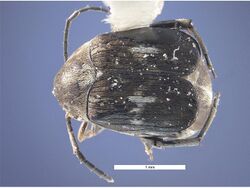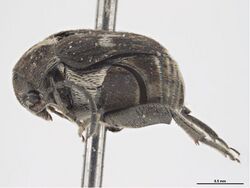Biology:Zabrotes subfasciatus
| Zabrotes subfasciatus | |
|---|---|

| |
| Scientific classification Error creating thumbnail: Unable to save thumbnail to destination
| |
| Domain: | Eukaryota |
| Kingdom: | Animalia |
| Phylum: | Arthropoda |
| Class: | Insecta |
| Order: | Coleoptera |
| Infraorder: | Cucujiformia |
| Family: | Chrysomelidae |
| Genus: | Zabrotes |
| Species: | Z. subfasciatus
|
| Binomial name | |
| Zabrotes subfasciatus (Boheman, 1833)
| |
Zabrotes subfasciatus, the Mexican bean weevil, is a species of leaf beetle in the family Chrysomelidae. It is found in Africa, North America, South America, Southern Asia, and Europe.[1][2][3]
1833), commonly known as the Mexican bean weevil, is one of the main pests of the common bean (Phaseolus vulgaris) that affect seeds during storage (Morales et al., 2018). Weevils lay the eggs on the seed coat and then larvae feed and grow inside, which results in serious affectations including hollow grains with reduced nutritional quality and loss of viability. The economic impact caused by this insect pest has been reported to reach up to 35% production loss.[4][5]
Several chemical control methods have been effectively tested against bruchids; however, the use of toxic pesticides in a product that is about to be consumed represents a high risk, both for humans and the environment, which has evidenced the need for viable strategies to control the bean weevil through less harmful options that improve food safety and are compatible with sustainable production systems.[5][6][7][8] Taking into consideration that the high fecundity of the Mexican Bean Weevil is attributed to standard room temperature conditions, a potential solution is to adjust the temperature in the storage rooms where infestation has occurred. By lowering the temperature to colder degrees, the egg mortality rate is deterred significantly, and the preservation of the crop is prolonged due to the colder conditions.[9][10]
References
https://doi.org/10.1016/j.cbpb.2022.110770
- ↑ "Zabrotes subfasciatus Report". https://www.itis.gov/servlet/SingleRpt/SingleRpt?search_topic=TSN&search_value=187762.
- ↑ "Zabrotes subfasciatus". https://www.gbif.org/species/1048600.
- ↑ "Zabrotes subfasciatus species Information". https://bugguide.net/node/view/660755.
- ↑ (Rodriguez-Hernandez, 2001)[full citation needed]
- ↑ (Valencia-Catano, 2006)[full citation needed]
- ↑ (Grossi-de-Sa ´ et al., 2015)[full citation needed]
- ↑ (Dastranj et al., 2016)[full citation needed]
- ↑ Dendy, J.; Credland, P. F. (April 1991). "Development, fecundity and egg dispersion of Zabrotes subfasciatus" (in en). Entomologia Experimentalis et Applicata 59 (1): 9–17. doi:10.1111/j.1570-7458.1991.tb01481.x. ISSN 0013-8703.
- ↑ Magalhães, Cláudio P.; Fragoso, Rodrigo R.; Souza, Djair S.L.; Barbosa, Aulus E.A.D.; Silva, Carlos P.; Finardi-Filho, Flávio; Da Silva, Maria C.M.; Rocha, Thales L. et al. (December 2007). "Molecular and structural characterization of a trypsin highly expressed in larval stage ofZabrotes subfasciatus" (in en). Archives of Insect Biochemistry and Physiology 66 (4): 169–182. doi:10.1002/arch.20208. PMID 18000877.
Further reading
- Catalogue of Palaearctic Coleoptera, Volume 6: Chrysomeloidea. Apollo Books. 2013. ISBN 978-90-04-26091-7.
External links
Wikidata ☰ Q2421295 entry
 |


